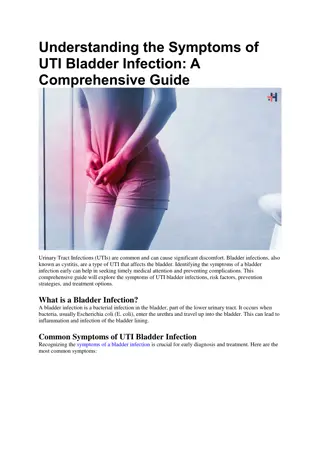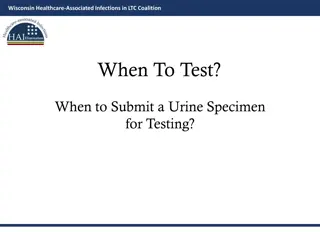Comprehensive Guide: Approach to UTI in Patients Including Types, Causes, and Diagnosis
This guide covers the approach to patients with UTIs, including types such as cystitis and pyelonephritis, common causes, organisms, presentation of symptoms, vesicoureteral reflux in children, asymptomatic pyuria in pregnancy, and diagnosis. It aims to provide a detailed understanding of UTIs and their management.
Download Presentation

Please find below an Image/Link to download the presentation.
The content on the website is provided AS IS for your information and personal use only. It may not be sold, licensed, or shared on other websites without obtaining consent from the author.If you encounter any issues during the download, it is possible that the publisher has removed the file from their server.
You are allowed to download the files provided on this website for personal or commercial use, subject to the condition that they are used lawfully. All files are the property of their respective owners.
The content on the website is provided AS IS for your information and personal use only. It may not be sold, licensed, or shared on other websites without obtaining consent from the author.
E N D
Presentation Transcript
Approach to patient with UTI HossamKhalid Alsahabi Waleed Khalid AL Shammari MazenAyidhAlotaibi
Objectives Types of UTI (Cystitis, Pyelonephritis) Causes Common organisms How patient presents VesicoUreteral Reflux in children Asymptomatic Pyuria in pregnancy Diagnosis When to start full investigations When to refer to specialist Management Prophylaxis Education
Question 1 What is the most common organism causing UTI? proteusmirabilis E.coli Klibsiella pneumoniae Pseudomonas aeruginosa
Question 2 Which of the following is considered as a risk factor for complicated UTI? High grade fever Severe flank pain Urinary tract obstruction Female gender
Question 3 Which one of the following is considered contraindicated in pregnant woman? Penicillin Cephalexin Fosfomycin Fluoroquinolone
Question 4 How to differentiate between cystitis and pyelonephritis in urinalysis? Nitrite WBC Casts RBC WBC
What is UTI definition ? Urinary tract infections happen when bacteria get into the urethra and travel up into the bladder. If the infection in the urethra, it is called a urethral infection or urethritis . If the infection stays just in the bladder, it is a called a bladder infection, or "cystitis." If the infection travels up past the bladder and into the kidneys, it is called a kidney infection or "pyelonephritis. UTI occur more commonly in women than men, with half of women having at least one infection at some point in their lives .
Types Location Lower Upper Cystitis Urethritis Prostatitis Pyelonephritis Abscess (Intrarenal & Perinephric) Recurrence Symptoms Recurrent 1 UTI / 6m Sporadic < 1 UTI / 6 m Symptomatic Asymptomatic Complication Factors Complicated Uncomplicated Infection in a urinary tract with functional or structural abnormalities. Infection in a structurally and neurologically normal urinary tract.
Cystitis It can caused by : Infection (which is usually happens ) Damage or irritation of the bladder (During sex) Women > Men (why?) Women tend to get them more often because their urethra is shorter and closer to the anus than in men. It can be more serious in men because it could be caused by: An underlying bladder or prostate infection, such as prostatitis. An obstruction in the urinary tract, such as a tumour, or an enlargedprostate.
Causes of Cystitis Usually caused by bacterial infection such as : E.Coli(most common G-ve) How its getting inside the Urinary system : Sex ( especially in young sexually active women it cause 75- 90%) Urinary catheter . Poor hygiene is a common cause Diabetes ( Sugary urine encourage the bacteria to grow up ) Postmenopausal women ( lower hormones lead to lowering the defense of urethra ) Kidney stones or Bladder stones .
Presentation of cystitis patient It takes several hours to a day . Common Symptoms include : Dysuria ( Burning urination ) Frequent and Urgent need to urinate. Pain in lower abdomen or lower back. Pain during sexual intercourse Cloudy, dark or strong smelling urine blood in urine (Haematuria ) Low grade fever
Pyelonephritis potentially organ or life-threatening infection that often leads to renal scarring. Its ascending from the lower part of urinary system Reach the pelvic of the kidney It cant reach the kidney by bloodstream . Its more common after a catheterization less than a month . The faster diagnosed and managed the better prognosis .
Causes E.Coli the most common organism as cystitis. Its carried by the bloodstream Presentation Vary from one and another depending on the age and the gender : Same as Cystitis symptoms Chills and fever . Nausea/Vomiting, diarrhea, tachycardia. Urine microscopy: Pyuria + WBC casts, bacteria and Hematuria Leucocytosis. Costo-vertebral (renal) angle Tenderness or deep abdominal tenderness .
Most Common Organisms Gram -ve Gram+ve E.Coli (Most Common) Enterococci Proteus mirabilis Group B streptococci Klebsiella spp Staphylococcus aureus Staph.Aureus E.Coli
Source: Ascending (commonest) Hematogenous(TB, perinephric abscess) Lymphatic Direct (IBD fistulas)
Predisposing Factors: Stasis and obstruction posterior urethral valves Reflux drugs (anticholinergics) Decreased resistance diabetes mellitus malignancy immunosuppression Other factors Foreign body trauma anatomic variance (congenital) catheter stone Instrumentation
History: irritative symptoms (fund) obstructive symptoms (wise) previous UTIs renal calculi sexual activity personal hygiene Hematuria pain tenderness costovertebral abdominal Rectal +/ fever, chills, nausea, vomiting sepsis/shock
Vesicoureteral Reflux in children a condition in which urine flows from the bladder, back towards or into the upper urinary tract. The refluxing urine increases the pressure within the kidneys and may contain bacteria that can lead to infection. Long term increased pressure and repeated infections can lead to kidney dysplasia.
The study to rule out reflux is MCUG and it is also used for grading:
VUR occurs in approximately 1/100 children. The majority of children with the condition will not require any treatment and will grow out of the condition in childhood; however a small number will require surgery to correct the condition.
As with the history, few findings on physical examination suggest VUR or UTI. Fever, flank or abdominal tenderness, or an enlarged palpable kidney may be present. The standard imaging tests include renal and bladder (US) and (VCUG).
Signs and symptoms Vesicoureteral reflux in itself does not produce any symptoms. These occur when infection of the urinary tract is present. Other symptoms commonly experienced include: Bedwetting (nocturnal enuresis). Lower abdominal pain. Hematuria and/or Pyuria (pus in the urine).
Children and VUR Prophylactic low dose ABX Indications for Surgical correction : Poor compliance with medical ragmen breakthrough infection despite antibiotic prophylaxis Progressive renal scarring Sever reflux (Grade IV or V) FIRST manage the new-borns medically until they be old enough for surgery.
Asymptomatic Bacteriuria in Pregnant Women Occurs in 2% to 7% of pregnancies. More than 80% of cases the infecting organism E.coli. ABU in pregnancy is significant because 20-30% of untreated cases progress to acute pyelonephritis.
Cont. Treatment of ABU in pregnancy consists of oral antibiotics for 14 days. One of the following agents may be used: Ampicillin & cephalosporins are generally safe and effective during any phase of pregnancy Treatment of ABU in pregnancy reduces the frequency of acute pyelonephritis to 2-3%.
In straightforward cases, a diagnosis may be made and treatment given based on symptoms alone without further laboratory confirmation
Investigations midstream urine M, C&S (routine) urine cytology (if indicated) IVP/ultrasound (if indicated) cystoscopy (if indicated) spiral CT (if indicated) voiding cystourethrogram (VCUG) if recurrent and/orhydronephrosis
Dipstick Urinalysis (Midstream urine) - Leukocyte esterase, nitrates, protein, and blood are the important features in evaluating for UTI. -A highly alkaline PH > 8 suggests infection
urine culture (Midstream urine) Urine in the bladder normally is sterile If the urine culture is positive Sensitivity analysis, helps find the right antibiotic to kill an infecting microorganism. This test determines the sensitivity of a colony of bacteria to an antibiotic
Microscopy Urinalysis - Looks for the presence of red blood cells, white blood cells, or bacteria. When coupled with classic symptoms, a finding of 2-5 WBCs or 15 bacteria per hpfin a centrifuged urine sediment is consistent with UTI. - The presence of many epithelial cells usually indicates a contaminated specimen.
The presence of 105CFU/mL of bacteria is the traditional diagnostic indicator for UTI. However, in the presence of dysuria and other symptoms for UTI, 102CFU/mL confirms the diagnosis.
Imaging and urologic intervention should be considered in the following patients: 1-Patients with a history of kidney stones. 2-Patients with diabetes. 3-Patients with polycystic kidneys are prone to abscess formation. 4-Patients with tuberculosis Have persistently not responded to treatment. 5-Patients have a history of renal tract disease or anomaly. 6-Patients have hematuria. 7-Patients are women with more than three confirmed infections in the preceding year (two confirmed infections in the case of men) with no known contributing comorbidity
Imaging in the emergency department is typically not necessary unless concomitant obstructive uropathyis suspected, as this is an emergent condition that requires prompt intervention. Modalities for this include ultrasonography, intravenous pyelography (IVP), contrasted (CT) scanning, or helical CT scanning of the urinary system.
Referral for assessment should be considered for men who have : -Symptoms of upper urinary tract infection (pyelonephritis). -Failure to respond to appropriate antibiotic therapy. -Frequent episodes of urinary tract infection (UTI) -this is stated as two or more episodes in a 3-month period. -Features of urinary obstruction (e.g. in older men, enlarged prostate). -History of pyelonephritis, calculi, or previous genitourinary tract surgery.
Urgent referral is indicated for men with suspected cancer : -Any age with painless macroscopic haematuria (If haematuria is associated with symptoms of UTI, or If UTI is not confirmed by urine culture, or if haematuria does not resolve with treatment of the UTI refer urgently. -Recurrent or persistent UTI associated with haematuria, in a male aged 40 years or older. -Unexplained microscopic haematuria, in a male aged 50 years or older. -With an abdominal mass identified clinically or on imaging that is thought to arise from the urinary tract.
referral criteria from primary care - recurrent UTI in woman : routine referral is recommended for women with recurrent UTIs : who have a risk factor for an abnormality of the urinary tract including women with: -Past history of urinary tract surgery or trauma -Past history of bladder or renal calculi -Obstructive symptoms such as straining, hesitancy, poor stream -Urea splitting bacteria on culture of the urine such as Proteus or Yersinia -Persistent bacteriuria despite appropriate antibiotic treatment -Past history of abdominal or pelvic malignancy -Symptoms of a fistula such as pneumaturia Urgent referral is recommended for women with recurrent urinary tract infections (UTIs) associated with haematuria (visible or non-visible) for investigations to exclude urological cancer
Management of Cystitis Men Women Course 3-5 days 7 14 days -Trimethoprim-sulfamethoxazole - fluoroquinolones - Trimethoprim-sulfamethoxazole - Nitrofurantoin - B-lactams( Augmentin) Antibiotics To alleviate burning pain during urination, phenazopyridine (Pyridium) or a similar drug, can be used in addition to antibiotics for one to two days.
Prophylaxis when and what to give Antimicrobial prophylaxis : Antimicrobial prophylaxis has been demonstrated to be highly effective in reducing the risk of recurrent UTI in women. Prophylaxis has been advocated for women who experience two or more symptomatic UTIs within six months or three or more over 12 months
1-Continuous prophylaxis:Numerous studies have demonstrated that continuous prophylaxis decreases recurrences by up to 95 percent compared with placebo or with patients' prior experience
2- Postcoitalprophylaxis : (a single postcoital dose) may be a more efficient and acceptable method of prevention than continuous prophylaxis in women whose UTIs appear to be temporally related to sexual intercourse. Depending upon the frequency of intercourse, postcoital prophylaxis usually results in receipt of smaller amounts of antimicrobials than continuous prophylaxis
Education You can take these steps to reduce your risk of urinary tract infections: 1. Drink plenty of liquids, especially water. Drinking water helps dilute your urine and ensures that you'll urinate more frequently allowing bacteria to be flushed from your urinary tract before an infection can begin. 2. Drink cranberry juice.Although studies are not conclusive that cranberry juice prevents UTIs, it is likely not harmful. 3. Wipe from front to back. Doing so after urinating and after a bowel movement helps prevent bacteria in the anal region from spreading to the vagina and urethra. 4. Empty your bladder soon after intercourse.Also, drink a full glass of water to help flush bacteria. 5. Avoid potentially irritating feminine products.Using deodorant sprays or other feminine products, such as douches and powders, in the genital area can irritate the urethra. 6. Change your birth control method. Diaphragms, or spermicide- treated condoms, can all contribute to bacterial growth.
Case 1 A 32-year-old man came to the clinic because of burning on urination with increased frequency and urgency to urinate dysuria, For the last 7 days, with normal body temperature.
Which investigation you have to request? - Urinalysis - Urine culture is important when diagnosis is not clear or UTI is recurrent - Sonogram and CT to know the cause (for who do not respond to appropriate antimicrobial therapy, to rule out complications and other disorders)























